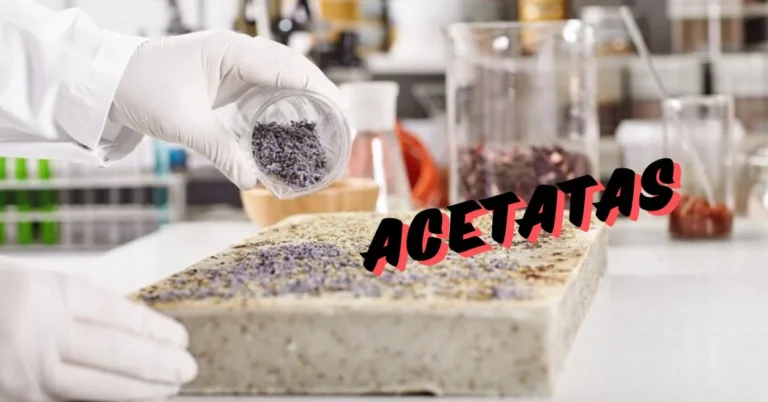Introduction to Acetates
Welcome to the world of Acetatas, where versatility meets innovation! These chemical compounds may sound simple, but their industrial applications are anything but. From textiles to pharmaceuticals, acetates play a crucial role in various industries, offering a wide range of benefits and possibilities. Join us on a journey as we explore the fascinating realm of Acetatas and uncover their secrets for success in modern manufacturing processes.
Types of Acetatas and their Properties
Acetatas come in various forms, each with its own unique properties and characteristics. One common type is cellulose acetate, which is derived from wood pulp or cotton fibers. This type of acetate is known for its biodegradability and versatility in applications such as textiles and packaging materials.
Another type of acetate is ethyl acetate, a colorless liquid with a fruity odor commonly used as a solvent in paints, varnishes, and nail polish removers. Its fast evaporation rate makes it ideal for quick-drying coatings.
Vinyl acetate is yet another variation that finds extensive use in the production of adhesives, coatings, and emulsion polymers due to its ability to polymerize easily under specific conditions.
The diverse types of acetates offer a wide range of properties suitable for various industrial applications, making them valuable components in numerous products across different sectors.
Common Uses of Acetatas in Various Industries
Acetatas are versatile compounds with a wide range of applications across various industries. In the textile industry, acetates are commonly used to create luxurious fabrics like satin and taffeta, known for their lustrous finish and draping quality. These fabrics are popular in evening wear, bridal gowns, and linings due to their elegant look.
In the pharmaceutical industry, acetates are utilized as excipients in drug formulations to improve solubility and stability of medications. Acetates act as binders in tablets or coatings for capsules ensuring proper drug delivery mechanisms. Additionally, acetate polymers find application in packaging materials due to their barrier properties against moisture and gases.
In the automotive sector, acetates play a role in manufacturing safety glass for windshields by serving as an interlayer that holds broken glass pieces together upon impact. The chemical resistance of acetates also makes them ideal for use in industrial cleaning products and adhesives across different sectors.
Advantages and Disadvantages of Using Acetatas
When it comes to Acetatas, there are several advantages that make them a popular choice in various industries. One of the main benefits is their versatility – acetates can be easily tailored to meet specific requirements, making them ideal for a wide range of applications. Additionally, acetates are known for their excellent clarity and optical properties, making them perfect for use in products where transparency is crucial.
On the flip side, one of the disadvantages of using acetates is their susceptibility to degradation when exposed to certain chemicals or environmental conditions. This can limit their lifespan and durability in some applications. Another drawback is that acetates may not be as heat resistant as other materials, which could restrict their use in high-temperature environments.
While acetates offer many advantages such as versatility and optical clarity, it’s essential to consider potential drawbacks like vulnerability to degradation and limited heat resistance before choosing them for industrial applications.
Case Studies: Successful Industrial Applications of Acetatas
In the automotive industry, Acetatas are used in the production of safety glass for windshields and windows. The high clarity and impact resistance of acetates make them an excellent choice for ensuring driver visibility and passenger safety.
In the pharmaceutical sector, acetatas are utilized in the formulation of various medications due to their compatibility with active ingredients. This ensures that the drugs remain stable and effective throughout their shelf life.
The textile industry benefits from acetates in the manufacturing of fabrics like rayon, which offers a luxurious feel and drapes beautifully. Acetate fibers are also known for their moisture-wicking properties, making them ideal for activewear and linings.
In electronics manufacturing, acetates play a crucial role in producing circuit boards and electronic components. Their heat-resistant nature makes them suitable for applications where thermal stability is essential.
These case studies showcase how versatile acetates are across different industries, proving to be a valuable material with a wide range of successful industrial applications.
Emerging Trends in the Use of Acetates
As industries continue to evolve, so do the applications of acetates. One emerging trend is the increased use of bio-based acetates derived from renewable sources like cellulose. This eco-friendly approach aligns with the growing demand for sustainable materials in various sectors.
Another notable trend is the advancements in technology allowing for the development of specialty acetates with enhanced properties such as improved heat resistance or UV protection. These innovations open up new possibilities for utilizing acetates in cutting-edge products across different industries.
Moreover, there’s a rising interest in exploring nanotechnology to enhance the performance characteristics of acetate materials even further. By incorporating nanoparticles into acetate formulations, researchers aim to create ultra-lightweight and durable solutions suitable for demanding industrial applications.
These emerging trends signal a promising future for acetates as versatile materials capable of meeting evolving industry needs while also contributing to a more sustainable and innovative landscape.
Conclusion: The Future of Acetatas in Industry
Acetatas have proven to be versatile and essential compounds in various industries. With their wide range of applications, from textiles and pharmaceuticals to automotive and construction, acetates continue to play a crucial role in modern manufacturing processes. As technology advances and sustainability becomes increasingly important, the future of acetates in industry looks promising.
Innovations such as bio-based acetates and recycling initiatives are set to further enhance the sustainability profile of these materials. Manufacturers are exploring new ways to incorporate acetates into products that meet both performance requirements and environmental standards. This shift towards more eco-friendly practices aligns with consumer demands for greener solutions.
As industries adapt to changing market dynamics and regulatory landscapes, acetates will remain relevant due to their unique properties and versatility. By staying abreast of emerging trends and developments in the field of chemistry, businesses can leverage the benefits of acetates to drive innovation and competitiveness.
The future of acetates in industry is bright, with opportunities for growth and advancement on the horizon. By embracing sustainable practices, harnessing technological advancements, and exploring new applications, companies can maximize the potential of acetates as valuable components in a wide range of products. As we look ahead, it’s clear that acetates will continue to play a vital role in shaping the industrial landscape for years to come.
FAQs
What are Acetatas?
Acetatas are chemical compounds derived from acetic acid. They are versatile and widely used in various industries due to their unique properties, such as biodegradability, solubility, and the ability to form clear, strong films.
What are the common types of acetates and their applications?
- Cellulose Acetate: Derived from wood pulp or cotton fibers, used in textiles and packaging due to its biodegradability.
- Ethyl Acetate: A colorless liquid with a fruity odor, used as a solvent in paints, varnishes, and nail polish removers.
- Vinyl Acetate: Used in adhesives, coatings, and emulsion polymers for its ability to polymerize easily.
How are acetatas used in the textile industry?
Acetatas are used to create luxurious fabrics like satin and taffeta, known for their lustrous finish and draping quality. These fabrics are popular in evening wear, bridal gowns, and linings.
What are the advantages and disadvantages of using acetatas?
Advantages:
- Versatility in applications
- Excellent clarity and optical properties Disadvantages:
- Susceptibility to degradation from certain chemicals
- Limited heat resistance
What are some emerging trends in the use of acetatas?
Emerging trends include the development of bio-based acetatas from renewable sources and the enhancement of acetate properties through nanotechnology. These trends aim to improve sustainability and performance in various industrial applications.

